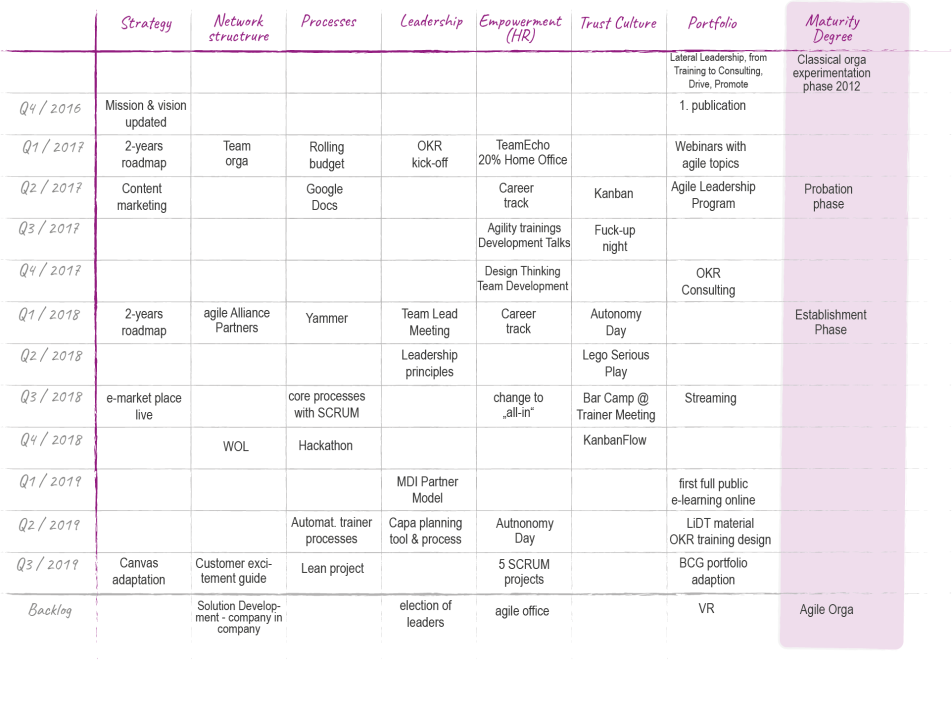Agile affects almost each company. Some thrive on agile, some panic, some hate the word already. If you come to the conclusion that for your organisation some or intense agile transformation makes sense, then the Agile Change Journey (ACJ) could help you to plan and monitor your venture.
The ACJ is based on the 7S model of McKinsey and the Trafo model of HR pioneers. It is a matrix consisting of
- Change Dimensions (horizontal) and
- time (vertical): The two left vertical columns show quarters and the degree of agile transformation.
You can decide to add or subtract Change Dimensions if that fits better to the needs of your organization. Whatever you choose, they should represent the most important fields in your business. Usually strategy, structure, processes, leadership and culture will play a role.
If you need to speed up a lot you could choose months instead of quarters in the timeline. The degree of agile transformation is being scaled between 1 and 10. 1 stands for a very traditional organisation and 10 for the ideal level of agility. 10 is not the same for a mining company and a media company. It depends on the dynamics of the technical, economical, ecological etc. environment and on what the core stakeholders of the organisation want to achieve. And 10 might be different in e.g. 2 years, as the market is constantly changing.
You do not need to limit yourself to thinking in categories of your own industry. That is why we added the product/solution portfolio to the transformation dimensions. Perhaps you sell products and services now and in the future you will offer software that will substitute your product range of today.

The MDI Agile Change Journey
The MDI Agile Transformation journey
Our Journey started in 2012 exactly by questioning our solution portfolio. At a strategy meeting we defined, that in 2022 we want to gain 40% of our revenue with “e-services”. Before we were a leadership development company doing seminars in seminar hotels. In the meantime, we offer mostly blended learning solutions (a mix of webinars, learning transfer software, e-learning, virtual and presence coaching, streaming, personality analysis etc.) on the one side and Agile Transformation Consulting on the other side.
In 2016 we didn’t have a good year. There was a 9% shrink in revenue and higher people turnover. This pain pressure helped to take the agile transformation seriously. We changed the whole leadership and organization structure to customer focused teams. In November our alliance partner Haufe invited us to join in helping a big German car builder to introduce OKR with trainings. In order to be able to work on the basis of own experience we decided to introduce OKR at MDI as of January 1st 2017.
OKR turned out to be the backbone of our agile transformation process. We realized that we need and want to re-formulate our mission and vision. I am almost ashamed to say, but before that we also had an expressionless vision statement “becoming the leading leadership development provider”. After the revision, we did not want to talk about ourselves anymore but about our contribution and the importance of responsible leadership on this planet:
Mission: We support leaders who want to improve their environment.
Vision: Sustainable leadership culture for a better world.
And we started with drafting our first 2-years strategy road map. Now we had a better basis for defining the quarterly objectives and key results.
As we shifted to quarters we also changed from yearly budgeting to a rolling budget: Each quarter for the next 12 months. That made a lot of sense, because before often in April we already knew that reality is far from our budget.
Most companies used to make yearly employee satisfaction surveys. We discovered Team echo. From that moment on we get employee feedback on a weekly basis. In order to increase autonomy, we gave each team member the chance to work 20% of her time in the home office.
In Qu2/2017 we launched our first public Agile Leadership Program. It was time to adjust our leadership knowledge to the requirements of today. We changed our marketing strategy from push to pull. We stopped selling something, we started producing valuable content and people started to ask for our newsletter and social media contributions. We realized, that Google sheets do not only work for OKR, but they make cooperation more efficient by avoiding version conflicts and having easy access from where ever on the plant a team member sits.
The story continues: I will share the Quarters from Juli 2017 until Sept. 2019 in the next blog post. Looking forward to meeting you virtually again or meeting you at our Agile Leadership Certification.

